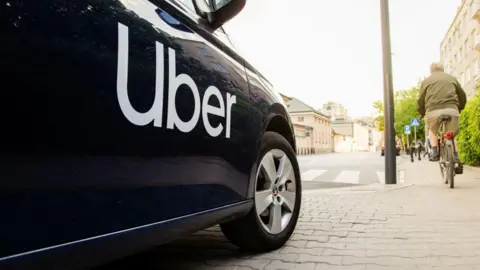In a recent report by the University of Oxford, startling findings have been unveiled regarding Uber’s dynamic pricing model and its impact on both passengers and drivers, particularly highlighting a troubling trend of rising fares juxtaposed with declining incomes for drivers. The research analyzed an extensive dataset from 258 Uber drivers in the UK, covering more than 1.5 million trips recorded between 2016 and 2024, revealing significant shifts since the introduction of the new pricing algorithm in 2023.
At the core of the study’s findings is the assertion that while fares for passengers have increased markedly, the earnings for drivers have virtually decreased. This dynamic pricing algorithm, as the study reveals, has enabled Uber to boost its revenue share, with the company’s commission escalating from approximately 25% to 29% following its implementation. In stark contrast, the hourly income for drivers has plummeted from over £22 to just above £19. Contributing to this decline, the study notes that drivers are now spending more unpaid time waiting for rides, further compounding their financial challenges.
Moreover, researchers emphasized the widening chasm between what Uber passengers pay and the compensation that drivers receive. The lead author of the study, Professor Reuben Binns, elucidated that this pricing model means higher trip values correlate with larger cuts taken by Uber, thereby reducing the actual earnings that drivers accumulate per minute of work. This unsettling revelation points to a system that financially disadvantages drivers even as it enhances passenger convenience.
The study’s implications have not gone unnoticed by industry stakeholders. James Farrar, a former Uber driver and an advocate for driver rights through the Workers Information Exchange, commissioned the study to substantiate these issues within the gig economy. He has previously campaigned for better treatment and recognition of drivers as workers rather than self-employed individuals, reflecting a broader concern regarding the labor practices of companies like Uber.
In response to the study’s claims, Uber has rejected many of the presented figures, labelling a portion of the assertions as “totally false.” The company maintains that drivers are always informed of their potential earnings before they accept a trip, suggesting a greater level of transparency than the research implies. Furthermore, Uber noted that in the UK, drivers collectively earned over £1 billion between January and March of the current year, which they believe highlights the viability of their platform for drivers amid accusations of unfair compensation.
The environment in which Uber operates has been particularly challenging since the company’s entry into Oxford in February. Traditional taxi drivers have expressed skepticism about Uber’s capability to thrive in a market where competition is fierce, urging that the operational dynamics are not conducive to sustainable profitability for drivers in the long term.
As a whole, the study serves as a critical examination of the gig economy, prompting questions about how companies like Uber can balance profitability with fair compensation practices. With rideshare platforms becoming increasingly integrated into urban transport systems, discussions surrounding regulatory frameworks and driver protection mechanisms are likely to become more prominent.
The tension between profitability for Uber and fair pay for its drivers continues to be a pressing issue. Amidst rising living costs and mounting pressures on gig workers, understanding the nuances of such economic models will be vital moving forward. Advocates for driver rights are hoping that studies like those from the University of Oxford will catalyze meaningful changes within the industry, framing discussions around wage fairness and sustainable business practices as central to the future of work in the rideshare sector.
As society increasingly relies on the gig economy for transportation, the implications of such studies extend beyond just Uber and its drivers, but resonate across numerous workers navigating the nuanced landscapes of freelance employment.











